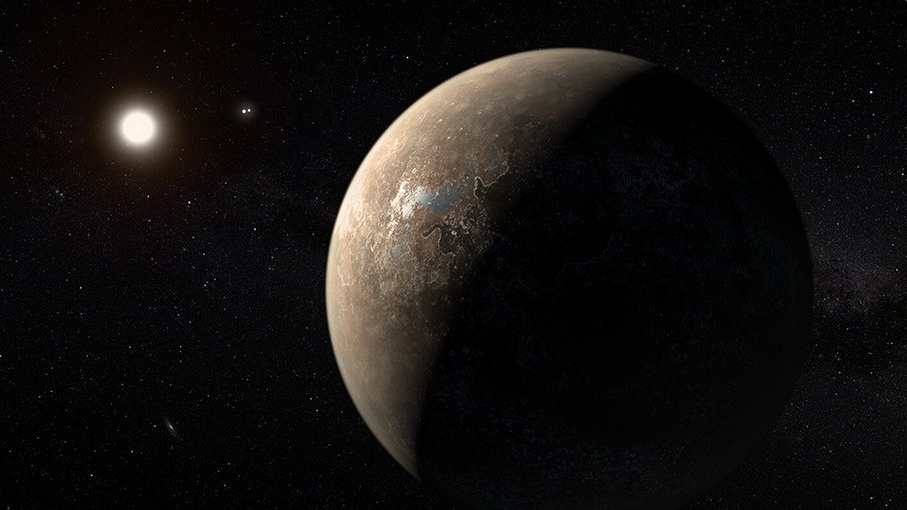NASA identifies 17 exoplanets with possible subsurface oceans
Some of these worlds may be home to vast watery oceans beneath their freezing surfaces.

As far as we know, life needs water.
Due to this simple truth, astronomers and astrobiologists have naturally focused their efforts on identifying exoplanets that might harbor liquid oceans. Water in its liquid form can exist on a planet's surface, where direct heat from its host star can keep the substance from freezing — but it can also exist beneath a planet's surface, where internal sources of heat can sustain flowing, subsurface oceans.
In a new analysis, NASA has revealed that 17 discovered exoplanets could house subsurface oceans buried below thick sheets of ice. These worlds, much like the icy moons of Jupiter, could therefore be promising places to search for biosignatures — chemical signs of life.
Related: NASA's exoplanet-hunting telescope spies 8 'super-Earths'
While the exact composition of these worlds remains unclear, estimates of their surface temperatures from previous studies point them being significantly colder than Earth. They're also each less dense than Earth, despite being roughly the same size as our planet.
"Our analyses predict that these 17 worlds may have ice-covered surfaces but receive enough internal heating from the decay of radioactive elements and tidal forces from their host stars to maintain internal oceans," Lynnae Quick of NASA's Goddard Space Flight Center said in a statement.
In other words, while their host stars may not provide conditions warm enough to keep water in liquid form on their surfaces, these planets may exhibit processes that can generate heat below their surface. The stretching and compression of rock inside a planet as it gravitationally interacts with its "sun," for instance, could provide significant amounts of internal heat — enough to sustain a subsurface ocean. The radioactive decay of heavy elements inside the core of a planet can provide intrinsic heat as well.
Get the Space.com Newsletter
Breaking space news, the latest updates on rocket launches, skywatching events and more!
"Thanks to the amount of internal heating they experience, all planets in our study could also exhibit cryovolcanic eruptions in the form of geyser-like plumes," Quick said, cryovolcanism meaning, in short, ice volcanoes.
The study drew on what we know from the geyser activity of two of Jupiter's moons, Europa and Enceladus. Two of the exoplanets named in the research, Proxima Centauri b and LHS1140 b, were particularly promising candidates for having oceans relatively near the surface.
"Since our models predict that oceans could be found relatively close to the surfaces of Proxima Centauri b and LHS 1140 b, and their rate of geyser activity could exceed Europa's by hundreds to thousands of times, telescopes are most likely to detect geological activity on these planets," said Quick.
Follow up observations of these worlds will likely include astronomers capturing the emission spectra of light traveling through these planets' atmospheres. Chemicals and molecules erupted into the atmosphere from cryovolcanic activity may hold clues as to whether life might exist in the cold dark depths of these worlds
The research was published in October in The Astrophysical Journal.
Join our Space Forums to keep talking space on the latest missions, night sky and more! And if you have a news tip, correction or comment, let us know at: community@space.com.

Conor Feehly is a New Zealand-based science writer. He has earned a master's in science communication from the University of Otago, Dunedin. His writing has appeared in Cosmos Magazine, Discover Magazine and ScienceAlert. His writing largely covers topics relating to neuroscience and psychology, although he also enjoys writing about a number of scientific subjects ranging from astrophysics to archaeology.
-
Questioner I am captivated (perhaps overly) that periodicy filters for limited discrete forms which dovetails into (self) replicating forms.Reply
I wonder if anyone has created a computer model with elements that connect & disconnect with energy entailed with some major regular periodic context to see the results?
i believe a rhythm favors some (sized? duration?) forms and tends to 'discourage' others that don't fit as harmoniously/efficiently.
It might graduate to storing energy in one phase and releasing & perhaps utilizing it in the counter phase. (sounds like breathing)
The idea that organic chemistry spontaneously self organizes into discrete, self animated forms would be hard for me to fathom. It seems too amorphous/undefined to me.
So i would be looking for bodies with liquid water AND have at least one distict & relevant periodical cycle. A moon (or two) &/or rotational spin or something else like that. (rhythmic geology? slow regular magnetic changes? periodic ocean currents/pulses/jets? heating-cooling? wet-dry?)
There probably isn't the resolution to discern any of those things yet.
I will put higher resolution on my Christmas wish list.









